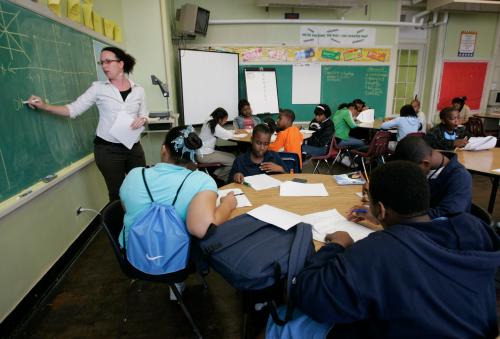In a recent Chalkboard blog post, Helen Ladd and John Singleton summarize their study of how much it costs school districts when children move to charter schools. Much of the analysis focuses on the city of Durham, N.C., where around 15 percent of all public school students now attend charters.
Some of the results are pretty shocking. The authors assert that in a locality spending $8,000 per student, each student who leaves the district to attend a charter school imposes an uncompensated cost of $3,500 on the district ($500 per traditional public school student).
On face, the authors’ concern seems legitimate. As they wrote:
[When losing enrollment,] the district cannot simply reduce its costs by 10 percent because some of its costs are fixed, especially in the short run. As a result, unless the district is able to offset the lost revenue with higher local tax revenue, it must cut its spending on variable inputs, such as teachers, by more than 10 percent.
Unlike a similar fiscal impact analysis published last week (and critiqued here) by the Oakland-based think tank In the Public Interest, Ladd and Singleton do not call for authorizers to consider slowing charter growth, but they do suggest states consider providing “transition aid” to cushion districts from the immediate pain of charter competition.
‘Costs’ analysis driven by shaky assumptions
An inconvenient fact for this paper is that Durham Public Schools, the district with the highest charter concentration, has not actually declined in overall enrollment in any measurable way. Over the past 30 years, enrollment has climbed steadily from approximately 18,000 students in 1989 to more than 34,000 in 2017, likely because of overall growth and demographic trends in the area.
So how can charters have a negative fiscal impact when the district has not actually lost any enrollment? Fiscal impact is measured against an idealized situation in which no child who left did so for any reason except to enroll in a charter. The authors also assume that, had district enrollment grown even more, the district would have found ways to exploit economies of scale. Both are highly debatable assumptions.
The authors also base their calculations on an unconventional definition of fixed costs, which includes any cost that takes some time to adjust, such as central administration and overall support and special education services to schools. But they then run a responsiveness test that shows that administrative and other truly variable costs constitute about half of the total so-called “fixed” costs.
The North Carolina Legislature (like those in other states) intended for students to have choices outside traditional districts, and for money to follow students to the schools their parents choose. Districts were expected to adjust their spending, not to hold on tight to old cost structures.
This is not some new imposition on school districts, which experience natural rises and falls in enrollment from time to time. Durham enrollment fell by 500 students in 1996 and 2006 due to changes in housing and employment, without setting off an anguished discussion of fixed costs and externalities.
Districts can face real challenges when it comes to dealing with declining enrollment, but this paper does not meaningfully explain or quantify them.
When students leave for any reason, districts no longer pay to educate them, but some costs–central office services, unused buildings, extra administrators and teachers, loans, and, in some states, debt-to-pension funds—can remain for a time. Special education costs can be a particular problem when, as in North Carolina, charter schools serve students with fewer special and costly needs.
Moreover, though enrollment ups and downs are common, districts are built to grow not shrink. A district whose enrollment is stagnant or falling can’t afford the salary and benefit escalations built into teacher contracts, or pay other costs that past school boards deferred to the present. Without enrollment growth, present-day schools (and kids) pay for yesterday’s commitments.
State law and regulation also work against flexibility, via fixed administrative structures for all schools, seniority-based salary scales, and maximum class sizes. Local politics also makes district leaders shrink from changing school enrollment boundaries, closing grossly under-enrolled schools and cutting central office jobs.
When enrollment declines, schools are also hamstrung by rules that constrain their internal organization, staffing, and spending. These rules include position allocation policies (for example, that each school, no matter how small, gets a principal and other administrative staff), and policies that prevent teachers from sharing some administrative functions.
Few districts have been aggressive in the face of enrollment decline, whether caused by charter schools or something else. Most cities with a lot of charter schools, though not Durham, experienced steady enrollment declines starting in the late 1960s. Some have dragged their feet. Others have adapted.
How Durham and other cities can respond
Districts that don’t rethink their policies and spending priorities accelerate their own declines—and it is kids who suffer most. Taking such actions forces district leaders to make tough decisions. But postponing them can only make matters worse, as charters or other factors reduce district enrollment.
Most costs that districts assume are fixed are not: They can be adjusted, albeit with some lags, as enrollment changes. Districts can, for example: pay off old debts and stop accruing new ones; petition the state for relief from escalatory salary schedules and LIFO (last in, first out) rules for reductions in force; assign the same principal and administrators to two schools; let teachers work part-time at more than one school; put new teachers on pay-as-you go pension and benefit plans; and sell any unused school buildings.
The key to district adaptation is funding students, not set staffing tables or districtwide programs. Transparent spending, combined with greatly enhanced school-level freedom to set priorities on staffing, facilities use, and purchases of teacher training, can allow a district to master its problems, protect school quality, and compete more effectively for students.
Durham has enjoyed overall citywide enrollment growth and has so far been largely protected from the impact of families choosing charter schools. It does have one special burden, however. North Carolina funds public education by allocating funds to support fixed staffing schemes, rather than students. This hamstrings adaptation to enrollment changes, by creating job entitlements and focusing politics on questions of employment stability and adult careers, not effects on children.
How charters can be a positive factor
As charters grow, it matters to everyone, including the families that rely on charters, when districts fail to respond in ways that stabilize school quality. The Center on Reinventing Education, our organization, has worked for years on how districts and charters can work together to maintain school quality for all kids, whether in district or charter schools. In a report we published last year, based on a collaboration among finance experts, district leaders, and charter leaders, we recommended that transition aid to districts or temporary slowdowns in charter growth might be needed in some circumstances to allow districts to adapt financially, but only when districts have already done everything possible to adjust spending.
Based on experience in Los Angeles, Cleveland, and other cities where charter and district leaders have worked together on behalf of all students, the charter community can help on:
- Looking across the district to identify neighborhoods and groups of children whom no school now serves well, and coordinating with the district on the creation of a needed option, whether chartered or district-run.
- Joining with district and city officials in petitioning for changes in state law and regulation (e.g. North Carolina’s staffing-based financing of districts) that limit districts’ and schools’ flexibility.
- Advocating equitable funding and other elements of a level playing field for all publicly funded schools.
Actions such as these do not amount to letting the district squelch charter growth or protecting districts from competition. Instead, they create a level playing field for a healthy public school choice system that benefits all students.
The Brookings Institution is committed to quality, independence, and impact.
We are supported by a diverse array of funders. In line with our values and policies, each Brookings publication represents the sole views of its author(s).









Commentary
School funds should follow students, not protect institutions
May 17, 2018